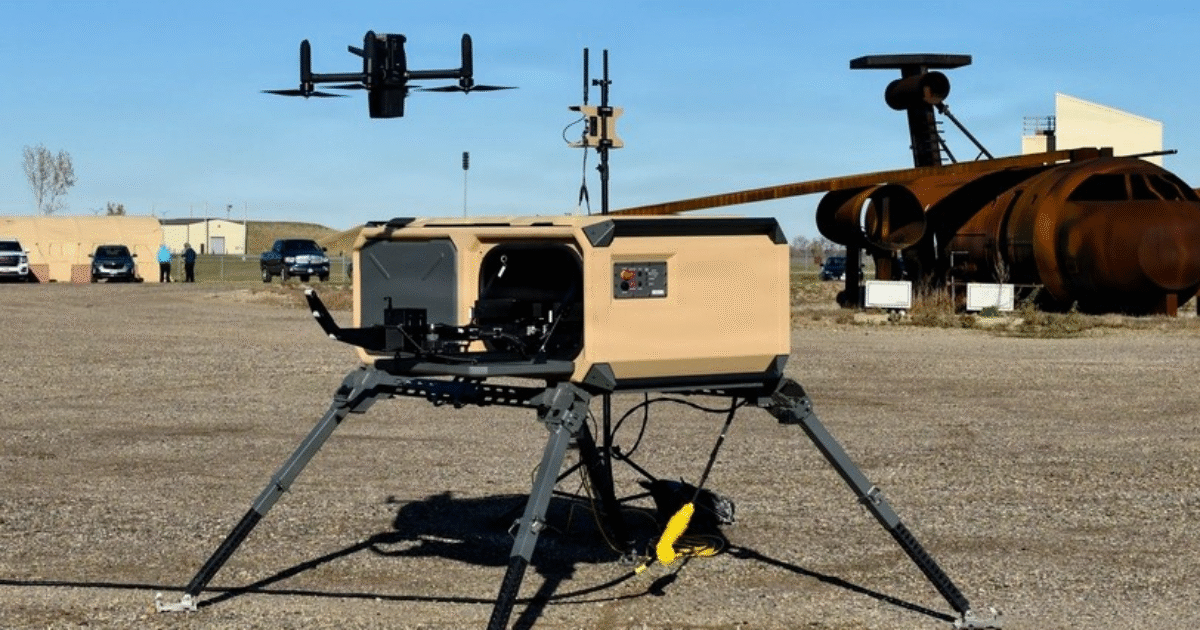Image: (USNORTHCOM C-sUAS Fly-Away Kit Certification by John Ingle)
As the popularity of commercial drones continues to rise in the United States, U.S. Northern Command (USNORTHCOM) is spreading a message. They warn that any attempts to illegally enter restricted military airspace with these devices could trigger defensive countermeasures.
Senate Intelligence Committee chairman Tom Cotton (R-AR) remarked in a CBS News interview last week that the threat of unmanned Aerial Vehicles (UAV), or drone, flights over military installations “is severe and growing.” According to the Department of War, in 2024, there were over 350 unauthorized drone flights recorded across approximately 100 military installations.
First shared by in a report by John Ingle, USNORTHCOM Public Affairs, the recent validation and certification of the Counter-small UAS (C-sUAS) fly-away kit, manufactured by Anduril, moves the nation closer to establishing a dependable means to address the threat posed by small drones.
The Gateway Pundit spoke to Chief Warrant Officer 3 Joey Frey, an evaluator for USNORTHCOM’s C-sUAS fly-away kit team, and Jason Mayes, the Branch Chief for C-UAS Operations and Readiness.
CW3 Frey referred to the kit as a “system of systems,” or multiple pieces of equipment, created to “detect and defeat” small aerial drones. To disable drones using the kit requires either a kinetic action, involving a physical hit, or a non-kinetic jamming method.
Regarding the increased number of drone incursions noted by Sen. Cotton, Mayes acknowledged that while it’s challenging to give an exact numerical figure, it doesn’t diminish the seriousness of the threat. He explained that the reason for this is that “detection capabilities have improved significantly over the last two years.” He explained, “It’s hard to know if we are actually seeing more drones or if we are just detecting more drones.”
Mayes said the concept for the fly-away kits began last year when Gen. Gregory Guillot, North American Aerospace Defense Command (NORAD) and USNORTHCOM commander, recommended that USNORTHCOM develop a capability to “allow for a crisis type response.” He emphasized that it is “very important” for the U.S. military to possess this capability and, given the nature of the threat, “the response has to be quick.”
CW3 Frey said, “The system itself is designed to be operated by only two people.” However, due to the extended hours of operation needed and the vast areas that must be secured, he suggested that a shift team covering 24 hours would also be necessary, recommending a total of around 12-16 personnel.
At USNORTHCOM, the military command neither recommends nor endorses any one capability for any branch of service, nor do they specify a date by which they would require C-UAS capabilities at some or all installations. Mayes said, “It’s an ongoing process, one that the services are going to ultimately decide.” During USNORTHCOM’s second C-UAS experiment on September 18, 2025, Gen. Guillot stated, “USNORTHCOM is very engaged with Department leaders to bring the right authorities to installations.”
What’s more, CW3 Frey said the National Defense Authorization Act (NDAA) is crucial in determining the necessary counter UAS strategy and the expected timeline for its implementation. However, according to him, “The goal would be to have a capability at most, if not all, in military installations.”
Currently, Mayes mentioned, there is one fly-way kit at Peterson Space Force Base. By April or May of next year, two more will be deployed at other military installations not yet disclosed.
“The plan is to strategically place them across the AOR to provide rapid response anywhere within [the continental United States and Alaska],” he shared. In the military, an area of responsibility, or AOR, refers to a designated geographic region that is assigned to a commander for the purpose of planning and carrying out homeland defense efforts
He said USNORTHCOM also has the Joint Counter-UAS Planner (JCUP) who assist installations working through the process of obtaining legal authority to use the kit, which accounts for regulations set in place by the Federal Aviation Administration (FAA).
The Branch Chief for C-sUAS Operations and Readiness also expressed, “This kit is not meant to bring everything down out of the sky. Just because you fly a drone doesn’t mean we’re going to shoot it down.” He explained, “There are certain parameters that have to be put in place before we can even turn the system on.”
“The system comes with a support team that operates both here out of USNORTHCOM as well as in the field to make sure that everything’s done legally and proper escalation of force is utilized prior to an engagement,” Mayes affirmed. “By all means, no one is trying to overstep anyone’s constitutional rights.”
The post U.S. Military Demonstrates Its Capability to Deploy to Bases and Address Rampant Drone Intrusions appeared first on The Gateway Pundit.











